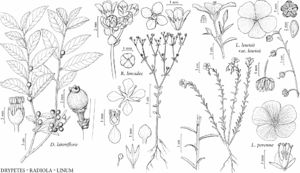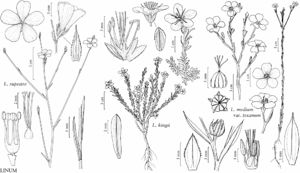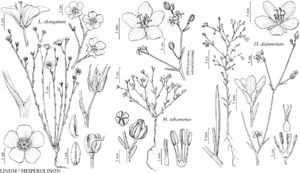Difference between revisions of "Linaceae"
FNA>Volume Importer |
imported>Volume Importer |
||
| (6 intermediate revisions by 2 users not shown) | |||
| Line 13: | Line 13: | ||
}}<!-- | }}<!-- | ||
| − | --><span class="statement" id="st-undefined" data-properties=""><b>Herbs </b>or subshrubs [shrubs, trees, vines], annual, biennial, or perennial. <b>Leaves</b> alternate, opposite, or whorled, simple; stipules absent or present as small, dark, spheric glands; petiole usually absent, rarely present; blade margins entire, serrate, or denticulate; venation pinnate. <b>Inflorescences</b> terminal, racemes, panicles, or cymes (rarely thyrses or corymbs in Linum) [spikes]. <b>Flowers</b> bisexual; perianth and androecium hypogynous; hypanthium absent; sepals 4–5, connate basally [distinct]; petals 4–5, distinct or coherent basally, imbricate or convolute, bases sometimes with appendages; nectary extrastaminal; stamens 4–5 [10], connate basally, filament tube and petal bases adherent or adnate [free]; anthers dehiscing by longitudinal slits; pistil 1, 2–5-carpellate, ovary superior, 4–5-locular, placentation axile or apical-axile; ovules 2 per locule, anatropous; styles 2–5, distinct or partly connate; stigmas 2–5. <b>Fruits</b> capsules, dehiscence septicidal, or indehiscent or schizocarps breaking into 4 nutlets (Sclerolinon). <b>Seeds</b> 2 per locule, seed coat often mucilaginous.</span><!-- | + | --><span class="statement" id="st-undefined" data-properties=""><b>Herbs </b>or subshrubs [shrubs, trees, vines], annual, biennial, or perennial. <b>Leaves</b> alternate, opposite, or whorled, simple; stipules absent or present as small, dark, spheric glands; petiole usually absent, rarely present; blade margins entire, serrate, or denticulate; venation pinnate. <b>Inflorescences</b> terminal, racemes, panicles, or cymes (rarely thyrses or corymbs in <i>Linum</i>) [spikes]. <b>Flowers</b> bisexual; perianth and androecium hypogynous; hypanthium absent; sepals 4–5, connate basally [distinct]; petals 4–5, distinct or coherent basally, imbricate or convolute, bases sometimes with appendages; nectary extrastaminal; stamens 4–5 [10], connate basally, filament tube and petal bases adherent or adnate [free]; anthers dehiscing by longitudinal slits; pistil 1, 2–5-carpellate, ovary superior, 4–5-locular, placentation axile or apical-axile; ovules 2 per locule, anatropous; styles 2–5, distinct or partly connate; stigmas 2–5. <b>Fruits</b> capsules, dehiscence septicidal, or indehiscent or schizocarps breaking into 4 nutlets (<i>Sclerolinon</i>). <b>Seeds</b> 2 per locule, seed coat often mucilaginous.</span><!-- |
-->{{Treatment/Body | -->{{Treatment/Body | ||
| Line 19: | Line 19: | ||
|discussion=<p>Genera 10–14, species ca. 260 (4 genera, 52 species in the flora).</p><!-- | |discussion=<p>Genera 10–14, species ca. 260 (4 genera, 52 species in the flora).</p><!-- | ||
--><p>Two subfamilies are generally recognized in Linaceae, the mostly herbaceous, temperate Linoideae Arnott (8 genera, ca. 240 species), in which all the genera in the flora area are placed, and the woody, mostly tropical Hugonoideae Reveal. Based on molecular phylogenetic analysis, J. R. McDill et al. (2009) concluded that Linaceae is a monophyletic group, as is Linoideae.</p><!-- | --><p>Two subfamilies are generally recognized in Linaceae, the mostly herbaceous, temperate Linoideae Arnott (8 genera, ca. 240 species), in which all the genera in the flora area are placed, and the woody, mostly tropical Hugonoideae Reveal. Based on molecular phylogenetic analysis, J. R. McDill et al. (2009) concluded that Linaceae is a monophyletic group, as is Linoideae.</p><!-- | ||
| − | --><p>According to J. R. McDill (2009), Cliococca Babington, Hesperolinon, and Sclerolinon are nested within Linum sect. Linopsis, and collectively these are sister to Radiola; Hesperolinon and Sclerolinon are most closely related to Mexican and Central American species of Linum. McDill et al. (2009) noted that the relationships within this clade are not well-enough resolved or supported to warrant nomenclatural changes; McDill (2009) came to the same conclusion based on a much wider sample of species. The current generic circumscriptions are maintained here.</p> | + | --><p>According to J. R. McDill (2009), Cliococca Babington, <i>Hesperolinon</i>, and <i>Sclerolinon</i> are nested within <i>Linum </i>sect.<i> Linopsis</i>, and collectively these are sister to <i>Radiola</i>; <i>Hesperolinon</i> and <i>Sclerolinon</i> are most closely related to Mexican and Central American species of <i>Linum</i>. McDill et al. (2009) noted that the relationships within this clade are not well-enough resolved or supported to warrant nomenclatural changes; McDill (2009) came to the same conclusion based on a much wider sample of species. The current generic circumscriptions are maintained here.</p> |
|tables= | |tables= | ||
|references={{Treatment/Reference | |references={{Treatment/Reference | ||
| Line 46: | Line 46: | ||
|-id=key-0-1 | |-id=key-0-1 | ||
|1 | |1 | ||
| − | |Sepals 4; petals . | + | |Sepals 4; petals 4. |
|[[Radiola|Radiola]] | |[[Radiola|Radiola]] | ||
|-id=key-0-1 | |-id=key-0-1 | ||
| Line 80: | Line 80: | ||
|basionyms= | |basionyms= | ||
|family=Linaceae | |family=Linaceae | ||
| + | |illustrator=John Myers | ||
| + | |illustration copyright=Flora of North America Association | ||
|distribution=North America;Mexico;West Indies;Bermuda;Central America;South America;Eurasia;Africa;Atlantic Islands;Pacific Islands;Australia. | |distribution=North America;Mexico;West Indies;Bermuda;Central America;South America;Eurasia;Africa;Atlantic Islands;Pacific Islands;Australia. | ||
|reference=mcdill2009a;mcdill2009b;mcdill2011a;rogers1975a;rogers1984b | |reference=mcdill2009a;mcdill2009b;mcdill2011a;rogers1975a;rogers1984b | ||
| Line 85: | Line 87: | ||
|publication year= | |publication year= | ||
|special status= | |special status= | ||
| − | |source xml=https:// | + | |source xml=https://bitbucket.org/aafc-mbb/fna-data-curation/src/2e0870ddd59836b60bcf96646a41e87ea5a5943a/coarse_grained_fna_xml/V12/V12_710.xml |
}}<!-- | }}<!-- | ||
-->[[Category:Treatment]] | -->[[Category:Treatment]] | ||
Latest revision as of 20:17, 5 November 2020
Herbs or subshrubs [shrubs, trees, vines], annual, biennial, or perennial. Leaves alternate, opposite, or whorled, simple; stipules absent or present as small, dark, spheric glands; petiole usually absent, rarely present; blade margins entire, serrate, or denticulate; venation pinnate. Inflorescences terminal, racemes, panicles, or cymes (rarely thyrses or corymbs in Linum) [spikes]. Flowers bisexual; perianth and androecium hypogynous; hypanthium absent; sepals 4–5, connate basally [distinct]; petals 4–5, distinct or coherent basally, imbricate or convolute, bases sometimes with appendages; nectary extrastaminal; stamens 4–5 [10], connate basally, filament tube and petal bases adherent or adnate [free]; anthers dehiscing by longitudinal slits; pistil 1, 2–5-carpellate, ovary superior, 4–5-locular, placentation axile or apical-axile; ovules 2 per locule, anatropous; styles 2–5, distinct or partly connate; stigmas 2–5. Fruits capsules, dehiscence septicidal, or indehiscent or schizocarps breaking into 4 nutlets (Sclerolinon). Seeds 2 per locule, seed coat often mucilaginous.
Distribution
North America, Mexico, West Indies, Bermuda, Central America, South America, Eurasia, Africa, Atlantic Islands, Pacific Islands, Australia.
Discussion
Genera 10–14, species ca. 260 (4 genera, 52 species in the flora).
Two subfamilies are generally recognized in Linaceae, the mostly herbaceous, temperate Linoideae Arnott (8 genera, ca. 240 species), in which all the genera in the flora area are placed, and the woody, mostly tropical Hugonoideae Reveal. Based on molecular phylogenetic analysis, J. R. McDill et al. (2009) concluded that Linaceae is a monophyletic group, as is Linoideae.
According to J. R. McDill (2009), Cliococca Babington, Hesperolinon, and Sclerolinon are nested within Linum sect. Linopsis, and collectively these are sister to Radiola; Hesperolinon and Sclerolinon are most closely related to Mexican and Central American species of Linum. McDill et al. (2009) noted that the relationships within this clade are not well-enough resolved or supported to warrant nomenclatural changes; McDill (2009) came to the same conclusion based on a much wider sample of species. The current generic circumscriptions are maintained here.
Selected References
Lower Taxa
Illustrations
Key
| 1 | Sepals 4; petals 4. | Radiola |
| 1 | Sepals 5; petals 5. | > 2 |
| 2 | Styles 5; fruits capsules, dehiscing into 5 or 10 segments. | Linum |
| 2 | Styles 2–3; fruits capsules dehiscing into 4 or 6 segments, schizocarps breaking into 4 nutlets, or indehiscent. | > 3 |
| 3 | Leaves: basal and proximal usually whorled, distal alternate or opposite; fruits capsules, dehiscing into 4 or 6 segments; styles 2–3, stigmas ± equal in width to styles; stipular glands present (exudate often red) or absent. | Hesperolinon |
| 3 | Leaves: proximal opposite, distal sometimes alternate; fruits schizocarps, breaking into 4 nutlets, or indehiscent; styles 2, stigmas wider than styles; stipular glands absent. | Sclerolinon |


